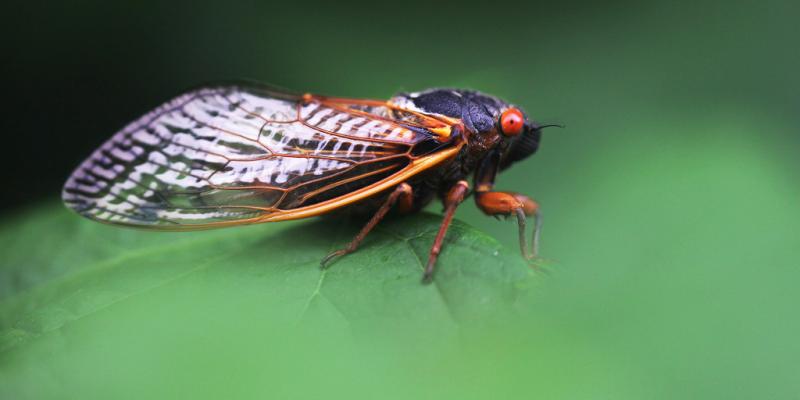Billions of cicadas will emerge in rare 2024 double-brood event



It's official: 2024 belongs to the cicadas.
This spring, two different broods of cicadas — one that lives on a 13-year cycle and the other that lives on a 17-year cycle — will emerge at the same time from underground in a rare, synchronized event that last occurred in 1803.
Billions of the winged insects will make an appearance across the Midwest and the Southeast, beginning in some places in late April, for a raucous mating ritual that tends to inspire fascination and annoyance in equal measure.
This year's dual emergence is a once-in-a-lifetime event. While any given 13-year brood and 17-year brood can occasionally emerge at the same time, each specific pair will see their cycles aligned only once every 221 years. What's more, this year's cicada groups, known as Brood XIII and Brood XIX, happened to make their homes adjacent to one another, with a narrow overlap in central Illinois.
"Thomas Jefferson was president the last time these two broods came out, so is it rare? Yes," said Gene Kritsky, an entomologist at Mount St. Joseph University in Cincinnati and author of "A Tale of Two Broods," a book about this year's dual emergence that was published earlier this month.
After 2024, Brood XIII and Brood XIX cicadas won't sync up their emergences again for another 221 years.
These types of cicadas are periodical insects that spend most of their lives underground feeding on tree roots. After 13 years or 17 years, depending on their brood, the cicadas will tunnel to the surface to reach maturity and engage in a monthlong, noisy search for a mate.
Cicadas typically surface in the spring once soil reaches a temperature of around 64 degrees Fahrenheit.

The blue map dots denote Brood XIII cicadas and the red dots are areas where Brood XIX has emerged in the past. These areas will likely have periodical cicadas in 2024.Cicada Safari
Brood XIII cicadas appear in the Midwest, mostly centered in Illinois but also stretching into Wisconsin, Ohio and Iowa. Brood XIX cicadas have been spotted over a much larger geographic area that includes Missouri, Illinois, Louisiana, North Carolina, Virginia and Maryland.
When these insects emerge, they do so in big numbers. And they're not exactly quiet in their mating frenzy.
The insects are known to emit a high-pitched buzz, or mating song, that can reach up to 100 decibels — roughly equivalent to a motorcycle or jackhammer.
The insects themselves are harmless to humans, but with billions of them set to emerge from underground, it can make for a noisy few weeks before the cicadas reach the end of their life cycles. Once that happens, it can also mean a lot of insect carcasses scattered on the ground.
It's the kind of spectacle that attracts some and repels others, said Kritsky, who released an app in 2019 called Cicada Safari that allows citizen scientists to report cicada sightings from their location.
"I've talked to half a dozen people already who want to go on vacation and come into the area to seek the cicadas," he said. "In years past, I've also helped people plan vacations to leave while the cicadas are here."
In parts of the Southeast, where Brood XIX cicadas make their home, the insects will likely start to pop up from underground beginning in late April.
Then, on a rolling basis as conditions warm throughout the Southeast and Midwest, more cicadas will surface through May and June.
Once they reach the surface, the insects shed their nymph exoskeletons and unfurl their wings. It typically takes several more days for their adult skin to harden.
The mating ritual itself is a whirlwind, with just weeks for cicadas to find a mate and lay their eggs before they die. The entire process lasts about six weeks.
"By July 1st, they're gone," Kritsky said.
While the cicadas are aboveground, however, scientists are keen to track where they appear. Kritsky himself will be studying cicadas around the Chicago area, and he's hoping people elsewhere across the Midwest and Southeast will report their own sightings on the Cicada Safari app.
Mapping the insects' range can help researchers understand how cicadas are adapting and changing between cycles. During this year's dual emergence, scientists are also interested in whether any cross-breeding will occur between the two distinct broods.
But even beyond science, this year offers a chance to experience a once-in-a-lifetime phenomenon, Kritsky said.
"This is my 50th year studying cicadas," he said. "I know there will be a lot of us in that boundary zone in Illinois, driving back and forth, meeting for coffee and having pie."




If you live near trees, the noise will drive you crazy, but one good thing, nobody needs to go hungry.
Roasted cicadas:
Adventure would be trying to collect enough for a meal.
You can scoop up enough from just under one tree - I know, cause I've seen it. It wouldn't take you more than a few minutes.
Well, if I survived eating grubs during jungle survival and escape training at Cubi Point in the Philippines, I could survive eating circadas.
Not here in TX.
We find a few molts every year, maybe 6 in a yard.
Morning Ed..I think I would have carked it in survival training..🤢🤢
I thought everything was bigger in Texas. For example, the steak I ate at the Dallas Traildust was the biggest I ever ate in my life.
You probably would. My class had a couple of Royal Australian Army troops going through the course. Those guys were good and tough as goanna hides! I remember halfway through the course, one asked the head instructor when the real training would begin?
Actually, since I DO eat escargots and oysters, why DON'T I try eating a cicada?
Because neither have eyes to speak of?
Morning...well it's rather appropriate for you as they do emit a high pitched buzz going by Google...
Ah, so that's where the expression "The ayes have it" came from. Actually, I don't like the idea of eating something that could be watching me do it.
That could make me a cannibal if I ate them. That "high-pitched buzz" competes with my tinnitus.
I enjoy both.
So glad I live in the dry arid desert in SE Arizona where we do not have them pesky little critters.
They must serve some purpose in evolution...
I'm sure they probably make great fish food, but I also think they are a evolutionary holdover from millions of years ago when there were vast inland seas and a lot more fish and other creatures that thrived on the nutrients they provided. They are like the human appendix, Something prehistoric that just is not needed any more.
Many kinds of birds eat cicadas.
Morning...it would be just a matter of evolution here, before they turned poisonous, sting you to death or eat you..😁
Very true
Could cicadas eat people? Since they spend part of their life cycle underground eating tree roots they would be capable of eating through a coffin and eating the remains that are inside it. Now we're getting macabre.
It would make a great Steven King novel and/or movie!